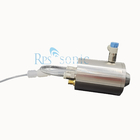
loading
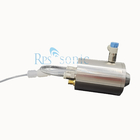

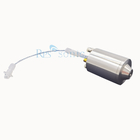

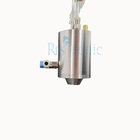

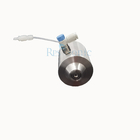

| Place of Origin | China |
|---|---|
| Brand Name | Rps-sonic |
| Certification | CE |
| Model Number | RPS-AT50 |
| Minimum Order Quantity | 1pcs |
| Price | negotiable |
| Packaging Details | CARTON |
| Delivery Time | 1DAYS |
| Payment Terms | T/T |
| Supply Ability | 200PCS/MONTH |
| Frequency | 50Khz | Power | 10~100w |
|---|---|---|---|
| Flow Rate | <20ml/min | Generator | 2000E/2000C |
| Solution Utilization | 98% | Weight | 10kg |
| High Light | Carbon Nanotubes Ultrasonic Spray Nozzles,Atomizing Ultrasonic Spray Nozzles,Ultrasonic Spray Nozzles 50Khz | ||
50Khz 100w Ultrasonic Atomizing Spray Nozzle For Carbon Nanotubes With Digital Generator
50khz 30watt atomization equipment ultrasonic spray coating easy to use
Paramater
| Item | Parameter |
| Frequency | 50Khz |
| Power | 10~100w |
| FLOW RATE (ml/min) | 0~20ml/min |
| Spray width | 2~200mm |
| Solution utilization | above 98% |
Ultrasonic Spray Nozzles
As their name implies, ultrasonic nozzles employ high frequency sound waves, those beyond the range of human hearing. Disc -shaped ceramic piezoelectric transducers
convert electrical energy into mechanical energy. The transducers receive electrical input in the form of a high frequency signal from a power generator and convert that into
mechanical energy at the same frequency.
The liquid is introduced to the atomizing probe with the use of a small pump or can be gravity feed. For the liquid to atomize, the vibrational amplitude of the atomizing surface must be carefully controlled. Below the so-called critical amplitude, the energy is
insufficient to produce atomized drops. If the amplitude is excessively high, the liquid is literally ripped apart, and large "chunks" of fluid are ejected, a condition known as
cavitation. Only within a narrow band of input power is the amplitude ideal for producing the nozzle's characteristic fine, low velocity mist.
The fine control of input energy is what distinguishes ultrasonic atomizing nozzles from other ultrasonic devices such as welders, emulsifiers, and ultrasonic cleaners; these other devices rely on cavitation with input power of the order of hundreds to thousands of watts. For ultrasonic atomization, power levels are generally under 15 watts. Adjusting the output level on the power supply controls power.
Since the atomization mechanism relies only on liquid being introduced onto the
atomizing surface, the rate at which liquid is atomized depends solely on the rate at which it is delivered to the surface. Therefore, every ultrasonic nozzle has an inherently wide flow rate range.
Ultrasonic Atomization
The phenomenon referred to as ultrasonic atomization has its roots in late 19th century acoustical physics, notably in the works of the ubiquitous Lord Kelvin.
Simply stated, when a liquid film is placed on a smooth surface that is set into vibrating motion such that the direction of vibration is perpendicular to the surface, the liquid absorbs some of the vibrational energy, which is transformed into standing waves. These waves, known as capillary waves, form a rectangular grid pattern in the liquid on the surface with regularly alternating crests and troughs extending in both directions.
When the amplitude of the underlying vibration is increased, the amplitude of the waves increases correspondingly; that is, the crest become taller and troughs deeper. A critical amplitude is ultimately reached at which the height of the capillary waves exceeds that require to maintain their stability. The result is that the waves collapse and tiny drops of liquid are ejected from the tops of the degenerating waves normal to the atomizing surface. A useful analogy that helps visualize this process comes from our everyday experience. Ocean waves coming into shore go through a transition from stability on the open water to instability as they approach shore. The instability is evident as the waves form foamy breakers.
The reason for instability in this type of wave is that as it approaches shore, the bottom of the wave contacts the ocean floor and is slowed down by frictional forces. The wave top, on the other hand, continues to move ahead unimpeded. The net result is that the wave topples over. In this process of breaking up, a spray of tiny drops is ejected from the wave surface. Although the mechanisms governing the creation of a spray from capillary and ocean waves differ, the results are similar.

| Frequency | 50Khz | Power | 10~100w |
|---|---|---|---|
| Flow Rate | <20ml/min | Generator | 2000E/2000C |
| Solution Utilization | 98% | Weight | 10kg |
| High Light | Carbon Nanotubes Ultrasonic Spray Nozzles,Atomizing Ultrasonic Spray Nozzles,Ultrasonic Spray Nozzles 50Khz | ||
50Khz 100w Ultrasonic Atomizing Spray Nozzle For Carbon Nanotubes With Digital Generator
50khz 30watt atomization equipment ultrasonic spray coating easy to use
Paramater
| Item | Parameter |
| Frequency | 50Khz |
| Power | 10~100w |
| FLOW RATE (ml/min) | 0~20ml/min |
| Spray width | 2~200mm |
| Solution utilization | above 98% |
Ultrasonic Spray Nozzles
As their name implies, ultrasonic nozzles employ high frequency sound waves, those beyond the range of human hearing. Disc -shaped ceramic piezoelectric transducers
convert electrical energy into mechanical energy. The transducers receive electrical input in the form of a high frequency signal from a power generator and convert that into
mechanical energy at the same frequency.
The liquid is introduced to the atomizing probe with the use of a small pump or can be gravity feed. For the liquid to atomize, the vibrational amplitude of the atomizing surface must be carefully controlled. Below the so-called critical amplitude, the energy is
insufficient to produce atomized drops. If the amplitude is excessively high, the liquid is literally ripped apart, and large "chunks" of fluid are ejected, a condition known as
cavitation. Only within a narrow band of input power is the amplitude ideal for producing the nozzle's characteristic fine, low velocity mist.
The fine control of input energy is what distinguishes ultrasonic atomizing nozzles from other ultrasonic devices such as welders, emulsifiers, and ultrasonic cleaners; these other devices rely on cavitation with input power of the order of hundreds to thousands of watts. For ultrasonic atomization, power levels are generally under 15 watts. Adjusting the output level on the power supply controls power.
Since the atomization mechanism relies only on liquid being introduced onto the
atomizing surface, the rate at which liquid is atomized depends solely on the rate at which it is delivered to the surface. Therefore, every ultrasonic nozzle has an inherently wide flow rate range.
Ultrasonic Atomization
The phenomenon referred to as ultrasonic atomization has its roots in late 19th century acoustical physics, notably in the works of the ubiquitous Lord Kelvin.
Simply stated, when a liquid film is placed on a smooth surface that is set into vibrating motion such that the direction of vibration is perpendicular to the surface, the liquid absorbs some of the vibrational energy, which is transformed into standing waves. These waves, known as capillary waves, form a rectangular grid pattern in the liquid on the surface with regularly alternating crests and troughs extending in both directions.
When the amplitude of the underlying vibration is increased, the amplitude of the waves increases correspondingly; that is, the crest become taller and troughs deeper. A critical amplitude is ultimately reached at which the height of the capillary waves exceeds that require to maintain their stability. The result is that the waves collapse and tiny drops of liquid are ejected from the tops of the degenerating waves normal to the atomizing surface. A useful analogy that helps visualize this process comes from our everyday experience. Ocean waves coming into shore go through a transition from stability on the open water to instability as they approach shore. The instability is evident as the waves form foamy breakers.
The reason for instability in this type of wave is that as it approaches shore, the bottom of the wave contacts the ocean floor and is slowed down by frictional forces. The wave top, on the other hand, continues to move ahead unimpeded. The net result is that the wave topples over. In this process of breaking up, a spray of tiny drops is ejected from the wave surface. Although the mechanisms governing the creation of a spray from capillary and ocean waves differ, the results are similar.









Ultrasonic Welding Equipment Ultrasonic Welding Transducer Ultrasonic Welding Converter Ultrasonic Liquid Processor Ultrasonic Cutting Equipment Ultrasonic Spray Nozzles Ultrasonic Power Supply Ultrasonic Soldering Equipment Ultrasonic Welding Horn Ultrasonic Assisted Machining Ultrasonic Testing Equipment
content is empty!